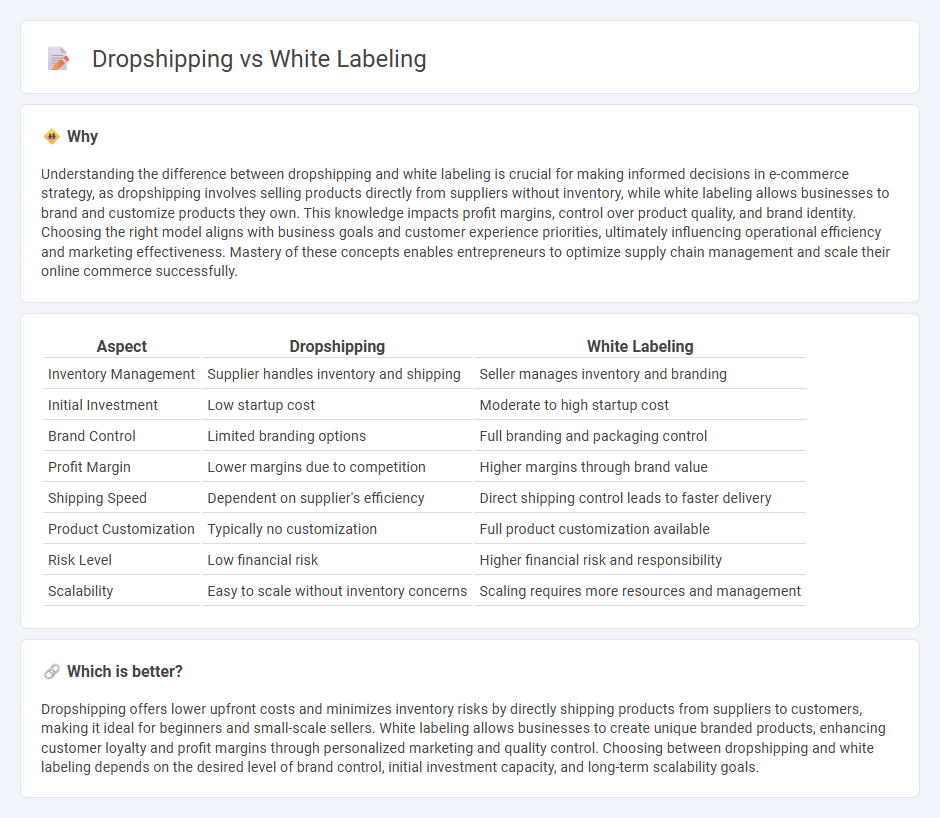
Dropshipping allows entrepreneurs to sell products without holding inventory by partnering with suppliers who ship directly to customers, reducing upfront costs and logistics challenges. White labeling involves purchasing generic products and rebranding them under your own label, providing higher control over branding and product quality but requiring inventory management. Explore the key differences and benefits of dropshipping versus white labeling to determine the best approach for your e-commerce business.
Why it is important
Understanding the difference between dropshipping and white labeling is crucial for making informed decisions in e-commerce strategy, as dropshipping involves selling products directly from suppliers without inventory, while white labeling allows businesses to brand and customize products they own. This knowledge impacts profit margins, control over product quality, and brand identity. Choosing the right model aligns with business goals and customer experience priorities, ultimately influencing operational efficiency and marketing effectiveness. Mastery of these concepts enables entrepreneurs to optimize supply chain management and scale their online commerce successfully.
Comparison Table
| Aspect | Dropshipping | White Labeling |
|---|---|---|
| Inventory Management | Supplier handles inventory and shipping | Seller manages inventory and branding |
| Initial Investment | Low startup cost | Moderate to high startup cost |
| Brand Control | Limited branding options | Full branding and packaging control |
| Profit Margin | Lower margins due to competition | Higher margins through brand value |
| Shipping Speed | Dependent on supplier's efficiency | Direct shipping control leads to faster delivery |
| Product Customization | Typically no customization | Full product customization available |
| Risk Level | Low financial risk | Higher financial risk and responsibility |
| Scalability | Easy to scale without inventory concerns | Scaling requires more resources and management |
Which is better?
Dropshipping offers lower upfront costs and minimizes inventory risks by directly shipping products from suppliers to customers, making it ideal for beginners and small-scale sellers. White labeling allows businesses to create unique branded products, enhancing customer loyalty and profit margins through personalized marketing and quality control. Choosing between dropshipping and white labeling depends on the desired level of brand control, initial investment capacity, and long-term scalability goals.
Connection
Dropshipping and white labeling intersect by enabling retailers to sell products without maintaining inventory, streamlining supply chain management and reducing upfront costs. In dropshipping, retailers source products directly from suppliers who ship items to customers, while white labeling allows retailers to brand and customize these products as their own, enhancing marketing control. This combination supports scalable e-commerce models by merging efficient logistics with personalized brand identity.
Key Terms
Branding
White labeling allows businesses to create a unique brand identity by customizing products with their own logos and packaging, enhancing customer loyalty and market differentiation. Dropshipping relies on third-party suppliers for product fulfillment, often limiting control over branding elements and packaging customization. Explore the advantages of each model to determine the best branding strategy for your business.
Inventory management
White labeling requires upfront inventory investment and stock management, enabling brand control and product customization, whereas dropshipping eliminates inventory handling by relying on suppliers to ship directly to customers, reducing risk but limiting control. Effective inventory management in white labeling ensures product availability and quality, while dropshipping prioritizes real-time order tracking and supplier reliability. Discover more about optimizing inventory strategies for both business models.
Supply chain
White labeling involves manufacturing products under a company's brand, giving control over product quality and inventory management within the supply chain. Dropshipping relies on third-party suppliers to fulfill orders directly to customers, minimizing inventory risk but limiting control over supply chain processes and delivery times. Explore detailed comparisons to determine which supply chain strategy aligns best with your business goals.
Source and External Links
What Is White Labeling and What Are Its Benefits - White labeling is a business practice where a company uses another company's product or service and applies its own branding to it, allowing quicker market entry with reduced costs and risk while increasing brand exposure and revenue streams.
What is White Labeling and How Does It Work? - Squarespace - White labeling involves a manufacturer producing a generic product that businesses rebrand and market as their own, enabling them to expand product lines efficiently without development or production investment.
What Are White Label Products? (2025) - Shopify - White label products are generic items sold under multiple brand names with identical construction, helping companies offer diverse products at reduced costs while leveraging established manufacturing.
 dowidth.com
dowidth.com